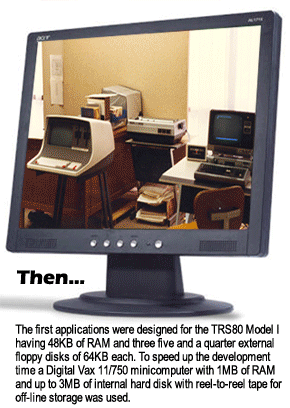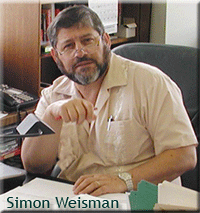|
Weisman Consultants and tower design software reach high achievement levels in the past 25 years
August 22, 2005 - Twenty-five years ago this month, development of the first commercially available tower engineering software began and what used to take a week to do can now be accomplished in less than a minute thanks to a young enterprising Canadian engineer who kept a commitment to a long-time friend and business associate.
After eight years in tower design and analysis at Morrison, Hershfield, Burgess, and Huggins Limited (MHBH), Simon Weisman left to start a new company that would help other engineers make use of computers in their work. The intention of Weisman Consultants Inc. (WCI) was to provide finite element analysis to engineers and business related software and training to small businesses.
Soon after establishing the company, Simon was approached by a friend, Kurt Penfold, a professional engineer who worked - and still works as V.P. of Engineering - at Trylon, to write software for the analysis of guyed towers, to be run on a Radio Shack TRS Model I. Young companies bite at every opportunity, so a contract was executed which made Trylon the first licensee of what was to become GUYMAST, the first commercially available guyed tower analysis program to run on a personal computer. Simon anticipated that there would be a total of six licensees.
Six months stretches to five years
Projected delivery was to be six months. The first delivery actually took place five years after the contract was signed but the software would run on the IBM XT personal computer rather than the TRS80. The first IBM XT to be delivered in the Toronto area was purchased by Trylon and supplied to WCI along with the Microsoft FORTRAN compiler. This microcomputer had 640KB of RAM and 10MB of hard disk.
 Although it took five years for Trylon to get their software delivered, it only took three years to finish GUYMAST and have it run on the Digital Vax 11/750. In those three years, the programming started on the TRS80 Model I having 48KB of RAM and three five and a quarter external floppy disks of 64KB each. Although it took five years for Trylon to get their software delivered, it only took three years to finish GUYMAST and have it run on the Digital Vax 11/750. In those three years, the programming started on the TRS80 Model I having 48KB of RAM and three five and a quarter external floppy disks of 64KB each.
"The computer kept crashing," Simon explained, "so everything had to be done in small independent modules and the data had to be continuously stored onto and retrieve from the floppy disks. Not only was the development time consuming, but the program execution also took a lot of time."
To reduce the amount of execution time and to work within the available RAM, the team of three came up with a method of sub-structuring that allowed for smaller matrixes and the use of partial data sets. A method that proved very convenient when it came to mining the data for producing graphical output and that is still part of the software today, 22 years later.
To speed up the development process development was transferred to a Digital Vax 11/750 minicomputer that made available about 1MB of RAM (20 times the TRS80 and 1.5 times the IBM XT) and up to 3MB of internal hard disk with reel-to-reel tape for off-line storage. The program architecture developed for the TRS80 was maintained because it was anticipated that it would have to be shoehorned back onto that smaller TRS80 machine.
License cost dropped to match hardware cost
Once the first copy of GUYMAST (for the Canadian standard) was delivered, WCI set about trying to find the other six clients, but without success. At $20,000 per copy, the license fee was considered too high. It had to be dropped to a quarter of that (to match the cost of the hardware) before any further sales took place. Of course, now the six clients would not be enough, so a marketing campaign to the US began. By this time, two years later, two more packages were available, MAST, for self-supporting towers, and MASTLOD, for calculating wind and gravity loads onto towers. Also, the TIA/EIA 222 standard had been incorporated. Once the software became a significant part of the Weisman Consultants Inc. revenue stream, it had to be rolled out to Guymast Inc. to protect the asset and to make engineering once more the major business at Weisman Consultants Inc.
Among the early US clients were AT&T Network Systems and V. G. Duvall in 1988. The following year Allied Tower and ARAMCO came on board and in 1990, Central Tower Inc and Al Babtain Industries bought licenses. In 1993 Electronics Research Inc became licensees.
The best years for license sales at WCI/Guymast Inc. were between 1996 and 2001, the peak years for the growth of the wireless infrastructure and with it suppliers and consultants. WCI did more for its competitors than it did for itself. Many consulting companies would not have established or if established would not have had such great, instant success without the GUYMAST software.
Weisman Consultants Inc. itself went on to assist many companies through engineering. It has provided inspections, mapping, analysis, design, and detailing services to all the major carriers in Canada and to some significant companies in the US, including Voice of America, Central Tower, Crown Castle, Pinnacle, and SpectraSite.
ICE evaluations can green light or halt a project
The latest innovation by Weisman Consultants Inc., through a related company called International Climatic Evaluations (ICE), is to supply site-specific design values for wind and ice. These values are derived in the same way as those in the ASCE maps, but are prepared with the topographic data of the particular site and the climatic statistics for the area in question.
The required statistical analysis is performed by scientists and engineers well trained in these procedures. Engineers experienced in tower design and knowledgeable in the requirements of the standards review these in order to make sure that the results are suitable for use in the design of towers.
A number of companies have taken advantage of this service to obtain a more realistic value of design wind in order to either save money on construction or reinforcement, in case the site-specific design values are lower, or, if they are higher, to manage the risk. As a result, there is a more advantageous distribution of the materials and costs, savings that could conceivably reach tens of thousands of dollars.
With the county listings in TIA/EIA-222-G sometimes showing a range of wind speeds, this service is definitely going to help the specification writer and designer find the most appropriate value.
The report gives a different wind profile for each direction that has different topographical characteristics allowing the design engineer to advantageously tailor the design of reinforcing for an existing tower.
Simon stays active in industry associations
In addition to serving on the TIA/EIA 222-G committee, Simon is Chairman of the CSA S37 committee in Canada that looks after the Canadian standard for tower design, CAN/CSA S37 01. He also chairs the ASCE Committee on Telecommunication Facilities that has set as its goal the matching up of research money with researchers who will do fundamental research on the behavior of tower components, where there is no good guidance for analysis or design, and wind loads on complex configurations of tower appurtenances. This should be of great value to tower owners and tenants that are forced to colocate. The ASCE committee will also qualify research proposals so that they are appropriate and useful to the industry that is funding it. This group will also provide a forum for the exchange of results from the research so that the entire industry benefits. The work done this way will also have an influence on future revisions of the standards.
Simon also participates on the IASS WG4 committee on Masts and Towers, which is an international working group discussing guyed and self supporting towers and their behavior.
Weisman Consultants Inc. sees itself as the home of imaginative engineering, predominantly working in support of other tower engineers and of tower suppliers. They currently have seven tower engineers, five programmers and five support staff.
"We're proud of the assistance our firm has provided to some of the more important tower engineering and supply firms in the US, Canada, and around the world over the last 25 years," Simon said.
Although the GUYMAST-G software released earlier this month makes it possible for the designer and analyst to quickly model the tower in a number of different ways, getting the information together is no different now than it was 25 years ago…perhaps, that will be Simon's next industry challenge.
For further information contact Weisman Consultants Inc. or Guymast Inc or call 416-736-7453.
|